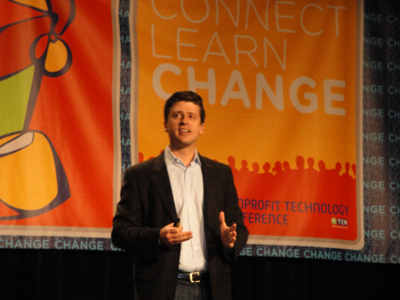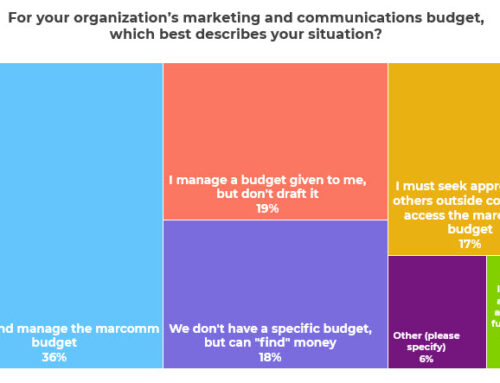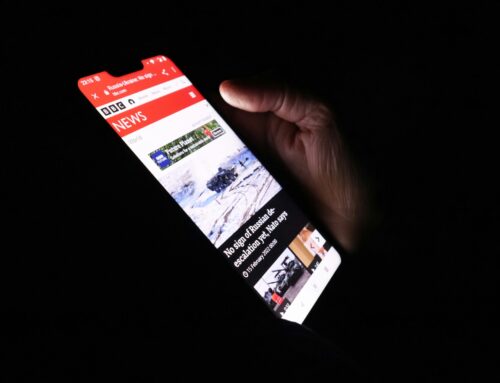Dan Heath, co-author of Switch: How to Change When Change Is Hard (Amazon) delivered a rousing keynote at the Nonprofit Technology Conference in DC last week. I read the book when it first came out, and was still completely enthralled by the presentation.
 I’m giving away a free copy of Switch — read on for details on how to enter the drawing.
I’m giving away a free copy of Switch — read on for details on how to enter the drawing.
The premise of the book is that change doesn’t always have to be hard or resisted. After all, getting married and having kids are huge life changes that most of us joyfully accept. The key, according to Dan, is understanding the Elephant (the emotional mind) and the Rider (the rational mind) in all of us.
Our Elephants can make us do stupid things, even when the Riders in us know they aren’t good ideas. “Of course you deserve to eat a whole pint of ice cream” and “checking your email for the millionth time isn’t procrastinating” and “it’s a fine idea to call your ex after too many drinks” are all things the Elephant says, according to Heath.
But that doesn’t mean our Elephants are villains. Elephants are also the creative ones who say “Wouldn’t it be cool if . . .” They also stop the Rider from sinking into too much “paralysis by analysis” by telling the Rider, “OK, that’s enough. Let’s move on and do this.”
So how can we get the Elephant and the Rider to work together? Switch outlines three steps:
1. Direct the Rider
One of the easiest and best ways to direct the rider is to train ourselves to stop focusing on problems and to start finding the bright spots — what is working — and to focus on replicating those instead.
For example, focusing on the problem sounds like this: “Not enough people have ‘liked’ our Facebook page. How can we reach people who haven’t liked our page and get them to click the Like button?”
Focusing on the bright spots would mean asking the people who have already liked the page why they did so. Find out what your brought your current fans to you and do more of that.
You are still giving your rider something to analyze, but it’s focused on the positives and what’s already working. As Dan said, people call friends for advice on relationship problems and talk your ear off, but they don’t call to discuss why their other relationships are so great (but they should, because that could solve the problem with bad relationship!)
What are the ingredients of your success? What were you doing when things were really fun and everything went smoothly? Those are your bright spots. Do more of that. Here’s how to enter the book drawing: Share your bright spots below in the comments, and I’ll randomly select one commenter as the winner.
2. Motivate the Elephant
Elephants are motivated by emotion, not education, plain and simple. No amount of facts and figures will change the Elephant — that’s all interesting to your Rider only.
Dan says that most people think the change process goes like this: Analyze > Think > Change. But it doesn’t. It’s much more like See > Feel > Change. This is exactly why you need to tell stories and give lots of examples in the content you create for donors, rather than rattling off a bunch of bullet points.
If change starts with a feeling, what feeling should it be? Dan talked about how nonprofits have historically used Pity (the Sally Struthers model of flies on eyes) and Guilt (taping the nickel to the direct mail appeal). He provided several good examples of why this approach back fires and chided the nonprofit sector for thinking that 1-2% response rates on direct mail were satisfactory. He urged us to focus on Hope and Success more than negative emotions like Pity and Guilt.
3. Shape the Path
Dan also talked about the importance of giving people clear instructions. This part of the talk produced my favorite quote of the day:
A jerk with a map is better than a saint without one. In other words, with clear directions, even people who are otherwise labeled as selfish will end up giving more than good-hearted people who are aren’t told how to help. When you obsess about the path, you greatly increase the odds that people will follow through on your call to action. That’s why it really does matter how many clicks it takes to get to your donation page, or to register for your event.
Finally, Dan urged us to accept failure as part of the path to success. He used this quote from a tobacco control campaign in California to illustrate:
“It took you years to start smoking. Why did you think you could quit the first time?” He also showed us a video of a baby learning to walk. The parents urged the baby to keep trying. When the baby fell, they didn’t say, “Well, I guess he isn’t cut out for walking.”
Greatness requires struggle. Change requires adaptation. Great change happens every day.
Book Drawing for a Copy of Switch
To enter the book drawing for a copy of Switch, leave a comment on this post sharing a “bright spot” in your work that you or your organization could try to replicate, rather than focusing on what’s missing.






